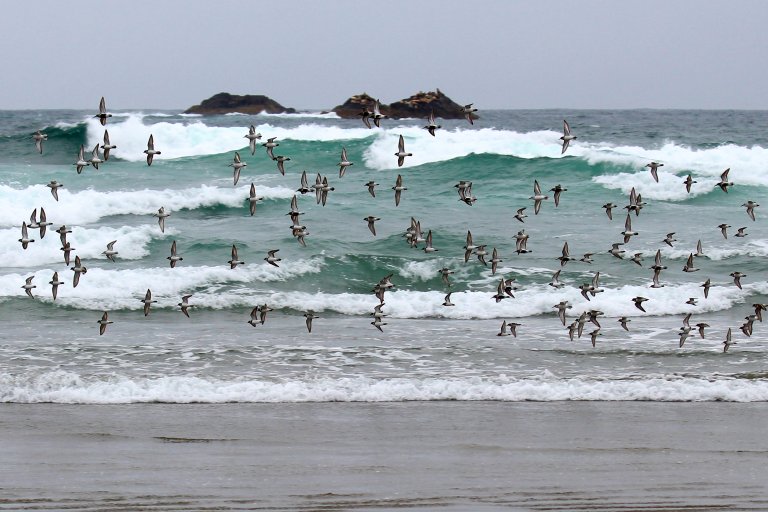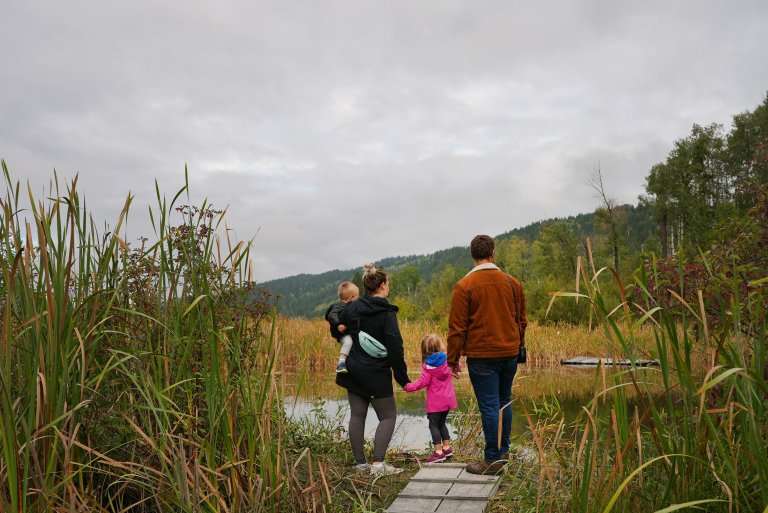Regarded as one of the world’s best road trip routes, Highway 99 stretches 377 kilometers from the US border northeast to Cache Creek, BC. But it’s at the northern tip of Howe Sound, in view of the towering Stawamus Chief Mountain, that the Sea to Sky corridor of this coastal route earns its namesake. Exploring the Sea to Sky Bird Trail takes you through Squamish and Whistler, two communities with unique birding opportunities.

Birding from the Coast to the Mighty Mountains
As the Squamish River diverges from Howe Sound, the Sea to Sky Bird Trail begins in Squamish, an outdoor-lover’s paradise. From hiking to rafting to mountain biking, there’s lots of nature to soak up and explore. Of course, that also means lots of trails for birdwatching, too! This area is also home to the UNESCO-designated Átl’ka7tsem/Howe Sound Biosphere Reserve which encompasses the fjord, its islands, and the extensive nature surrounding it.
Continuing north past Tantalus Lookout and Cheakamus Canyon, the globally-renowned chalet-style ski town of Whistler welcomes millions of visitors every year. With glaciated mountains on either side, it’s not hard to see why Whistler has been called the Valley of Dreams. The alpine is home to countless bird species, including some higher-altitude specialties like Canada Jay, Clark’s Nutcracker, and Ruffed & Sooty Grouse.
Where to See the Birds
Travelling to Squamish and Whistler on the Sea to Sky Bird Trail takes one through old-growth forests, bustling estuaries, and stoic mountains in search of birds.
Brackendale Eagles Provincial Park
Located along the Squamish River watershed in Squamish, this provincial park is recognized as one of the most significant areas for wintering bald eagles in North America. From November to February, bald eagles descend to feast on the runs of chum salmon in the Squamish, Cheakamus, and Mamquam rivers. The bald eagles come from all over the Pacific Northwest, including the interior of British Columbia, as the Squamish River area provides an ideal habitat for roosting, perching, and feeding.
The main viewing area is at the Eagle Run dyke. This can be accessed at Eagle Run Vista Point, parallel to Government Road along the dyke. Walk the trail and read up on bald eagles and salmon through the interpretive signage, and be sure to keep watch on the tree tops and over the water!
Skwelwil’em Squamish Estuary Wildlife Management Area
The Skwelwil’em Squamish Estuary is an essential and productive ecosystem for not only birds but fish and mammals as well. This beautiful estuary provides wintering, migration, feeding and breeding habitats for waterfowl, shorebirds, raptors, passerines and more migratory species. In the winter, large numbers of bald eagles can be seen feeding on the salmon. Watch for Purple Martins, Great Blue Herons, and Spotted Sandpipers as you explore the trails.
Year-round bird residents include Merlins, Peregrine Falcons, Bushtits, Kinglets, Brown Creepers, Pacific & Marsh Wrens, Red Crossbills, Pine Siskins, Red-winged Blackbirds, Steller’s Jays, and several woodpecker species. There are always birds to see!
The Skwelwil’em Squamish Estuary and its trails are accessible through downtown Squamish off of Main Street or at the end of Bailey Street.
Whistler Blackcomb
Whistler Blackcomb is known as one of the largest ski resorts in North America, but it also offers a very unique birding experience on the BC Bird Trail: alpine birding! Hiking trails on the mountains offer incredible views and are easily accessible by a gondola ride from the Whistler village base. Purchased lift tickets are required to get up to the mountains. Both Whistler and Blackcomb mountain offer short, family-friendly strolls on wide paths, as well as more advanced hikes that require preparation.
Summer is the best time for birding adventures on the mountains, as it’s the easiest time to access many of the mountain trails. Olive-sided Flycatchers, various raptors, and White-tailed Ptarmigan are only a few of the birds that can be seen at these heights. As the winter moves in, there will be fewer birds and skiing or snowshoe equipment is required to move about.
Be sure to check on the status of the lifts and trails on the Whistler Blackcomb website before heading out!
Information courtesy of Karl Ricker and Jim Wharin of the Whistler Naturalists Society.
Rainbow Park
Located at the northern end of Alta Lake, Rainbow Park is a popular summer destination in Whistler. For birding, follow the paved Valley Trail from the park up to the Emerald Forest Trailhead. You can either continue towards the Golden Dreams Conservation Area or head back to Rainbow Park.
Along the lake, there is a viewpoint where you can watch for Common Yellowthroats, Merlin, and depending on the season, American Dippers. If you’re lucky, you might even have a grouse (or family of them) cross your path!
In the spring, Whistler hosts around 200 species of birds that stopover on their migration along the Pacific Flyway.
Information courtesy of Heather Baines of the Whistler Naturalists Society.
Check out the self-guided itineraries of the Sea to Sky Bird Trail and its communities. Plan a birding adventure to best suit your ideal vacation.



